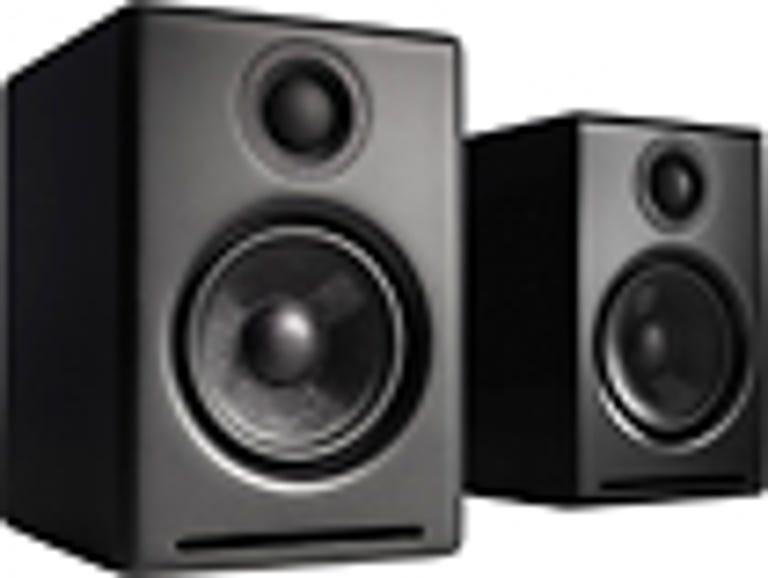We've been a little tardy in reviewing Audioengine's PC speakers, but we're glad we finally got our hands on both the 2 series ($199) reviewed here and the step-up Audioengine 5 series (about $325 online) because they really are quite impressive.
The Good
The Bad
The Bottom Line
The key thing to note about both sets of speakers is that they are bookshelf-style speakers masquerading as PC or "multimedia" speakers (as these things are apt to be labeled). But unlike classic bookshelf speakers, these Audioengine models are powered (via a standard AC plug); there's no need for a separate receiver or amplifier, so you can use them with any audio source. The smaller 2 series is more stylish-looking (and looks less like a monitor speaker) and comes in both black and white, as do the 5s.

The Audioengine 2 speakers measure 6 inches high by 4 inches wide by 5.25 inches deep. They each have a 2.75-inch Kevlar woofer and a 0.75-inch silk dome tweeter. Because the left speaker houses the amplifier (15 watts per channel), it's heavier than the right speaker. What's kind of interesting is that they're ported on the front--there's a slit at the bottom, below the driver--and when you're listening to movies, music, or games, you can feel plenty of air moving through that slit.
It's worth noting that both the 2 and 5 series Audioengine speakers come nicely packaged, with cloth covers over the speakers and cables. The two speakers connect to each other with "real" speaker wire (included) and you also get an input cable that allows you to connect your PC to the 3.5mm aux input on the back of the left speaker. The use of standard cables means that--unlike some speakers with proprietary connections and cables--you can invest in custom-length cables that are as long or short as you'd like. The left speaker also has a set of red/white RCA inputs to connect other devices, such as a game system, iPod or iPhone, or even a TV.

Note that you can't toggle between inputs; both are always active. That's either going to be a feature (say, the ability to listen to music from an iPod while being able to hear the bleeping and blooping from your PC) or a bug (the constant need to mute one audio source while listening to the other), depending on your point of view. Speaking of controls: no remote is included and we should point out that the volume control button is on the back of the right speaker (as opposed to the front, where it would be slightly easier to access). Another small drawback: the power adapter is kind of beefy.
Audioengine makes some accessories, including the S8 subwoofer and a couple of wireless adapters (the W1 and W2) for its speaker line. The subwoofer would obviously allow you to get significantly more bass and richer sound, but the downside is that the sub is actually pretty pricey ($350) and bringing in that extra speaker somewhat diminishes the sleek, minimalist effect these speakers offer (for Apple systems like the iMac, the white version of the 2 series tends to match up better than the black does).
Luckily, the appeal of these speakers is that you do without the sub. For their size, Audioengine 2s deliver deep, tight bass, and offer excellent detail and relatively big sound, even though they're so compact. True, the Audioengine 5s deliver a richer, fuller experience, but for many, the step-up model will just seem too bulky to leave sitting on a desk (they truly are bookshelf speakers with a more industrial, monitor flair to them).
As we said, we liked what we heard from these guys and so did Steve Guttenberg, who writes the Audiophiliac blog and reviews home theater speakers for CNET. He, too, praised the bass and noted that "the midrange and treble refinement are exceptional." You can crank the volume on the 2s but he, like this reviewer, thought they sounded better at more moderate volume levels.
Because they deliver such good sound for their size, we were tempted to give the Audioengines Series 2 speakers an Editors' Choice award, but ultimately we felt the higher-end 5s were more worthy, mainly because they offer even better sound and such niceties as a USB port for charging devices like iPods and iPhones, an extra 3.5mm input on the top of the speaker, and even a power outlet on the back of the speaker for plugging in additional audio sources, such as the Apple Airport Express. (Alas, the 5s don't include a remote either, which is too bad.)
In the final analysis, if you're looking for a set of compact, good-looking PC speakers that deliver great sound for their size, look no further. We should also mention that the Audioengine 2s perform better than most of the iPod speaker docks in this price range. Of course, it helps that you can separate the speakers to your liking, which allows for much better stereo imaging.



